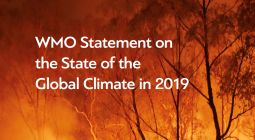WMO sees ‘enormous challenge’ to hit Paris targets as 1.5°c warming looms.

There’s a one in five chance that average global warming will hit 1.5°C above pre-industrial levels in at least one of the next five years, and a 70% chance that at least one month will exceed that threshold, according to the latest in a series of annual climate updates released yesterday by the World Meteorological Organization.
The UN agency says atmospheric carbon dioxide concentrations increased by almost three parts per million last year to about 413 ppm, the highest level in three million years, and methane levels increased at a rapid rate.
“This study shows—with a high level of scientific skill—the enormous challenge ahead in meeting the Paris Agreement on Climate Change target of keeping a global temperature rise this century well below 2.0°C above pre-industrial levels, and to pursue efforts to limit the temperature increase even further to 1.5°C,” WMO Secretary-General Petteri Taalas said in a release.
“WMO has repeatedly stressed that the industrial and economic slowdown from COVID-19 is not a substitute for sustained and coordinated climate action,” he added. “Whilst COVID-19 has caused a severe international health and economic crisis, failure to tackle climate change may threaten human well-being, ecosystems, and economies for centuries,” pointing to the need for governments to seize the opportunity to build back better.
“The predictions take into account natural variations as well as human influences on climate to provide the best possible forecasts of temperature, rainfall, wind patterns, and other variables for the coming five years,” the Geneva-based WMO explains. “The forecast models do not take into consideration changes in emissions of greenhouse gases and aerosols as a result of the coronavirus lockdown.”
In 2020, large parts of the northern hemisphere are expected to be 0.8°C warmer than the 1981-2010 average, the Arctic will have warmed at twice the global rate, and “many parts of South America, southern Africa and Australia are likely to be drier than the recent past.”
The report concludes that:
- Average global warming will likely hit at least 1.0°C in each of the next five years.
- Every region of the world except the southern oceans will be warmer than they’ve been in the recent past.
- High-latitude regions and the Sahel will likely be wetter, while the northern and eastern parts of South America are expected to be drier.
- Western Europe could see more storm activity, due to stronger westerly winds driven by changes in sea level pressure in the North Atlantic.
The report points to erratic weather contributing to flooding and droughts in many developing countries, weather extremes contributing to severe health effects for seniors in Europe, the rate of sea level rise growing exponentially year by year, and ocean oxygen levels continuing decline. The WMO calculates a 10% chance that average global warming will permanently hit the 1.5°C threshold by 2030.
9 July 2020
EcoWatch




